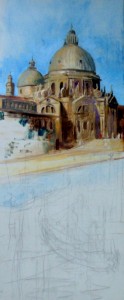subscribers: click on post title to view on the home page
How do you paint a masterpiece? One step at a time.
For some, the steps are all graceful. For most of us, it’s step (followed by breathe, look, think, feel, avoid, evaluate), and then step again. Sometimes we are sure of a step. Sometimes the step seems risky and we need to gather our courage.
This week’s assignment:
1. Think of a painting that you want to create.
2. Break the process down into steps.
3. Start taking those steps.
4. When a step seems too much, break it down into even smaller steps.
We’ll review the process using my recently completed commission of Venice. The size and subject were determined by the client. The painting needed to “match” a triptych that I painted for them a few years ago.
The subject wasn’t a natural fit with the canvas format – kind of like a square peg in a round hole. Designing the painting so that the subject would fit beautifully into the necessary proportions was the obvious first step.
I broke this design step into sub-steps. These steps included gathering all the references that I could find of the subject and doing Thumbnail Drawings to try out different compositions. The lesson on goal setting for artists might help you with this process of thinking though the steps.

The early stages of this painting focused on getting the architecture right. The foreground would be secondary and have more options in design.
Note: the hardest part for me is deciding on the next step. I don’t mind trying and failing – it’s not having a clue what to try that can leave me stumped for days. Then I try to find an even smaller step – maybe I’ll look at art books in a related style until something gives me an inspired idea of what might help my piece.
How about you? Please share your comments by scrolling to the bottom of this post.




Thank you for this post. When a project is very large and seems daunting I start doodling. I pick some part I’m attracted to and fiddle with that. This is a “hook” to going deeper. Once I start having fun I’m off and running. So much of Art and all we aspire to do is a confidence issue. Any way you can build your confidence is a launching pad.
I am so curious about the doodling process that you go through. Do you do it on scrap paper/ On the canvas? Does your mind bring up lots of new ideas. I think of doodling as constructive loafing around as it connects to things that weren’t conscious. What media do you use?
Hey – It’s neat when you answer my answer! The doodling is usually on a fresh sheet of legal-size bond paper which I buy in reams. I use a clutch pencil with a 3B lead and a kneaded eraser. I have a light box next to me and, rather than erase much, I trace my faulty drawing on another sheet and begin fresh. (A bit wasteful however the freshness gives me a boost. I use a cardboard box as a wastebasket.) I’m proud of this set-up and have sense of homecoming when I sit down there.
Thanks for explaining, Ann. This would be a process that I would like to video for the blog sometime!
It would be a kick to be video-ed someday.
Ann
I would love to see a video of that as well!
I, too, appreciate this post very much. I always love seeing how you develop a painting…And thank you for sharing your photos of the in-progress and the finished painting. I had the privilege of seeing this painting almost completed, and I must say, I think it is one of your best paintings this year.
I also appreciate what Ann had to say. I believe that I am a ponderer. When I “get a little stuck” I put the piece where I can study it casually as I pass by in a room I frequent a lot in our house…either the living room or the kitchen. Sometimes it will sit there for weeks before I begin on it again. Even though I may not stand and study it, keeping it around where I can see it a lot must keep my brain working on it. Often I have found that I have that “aha” moment when I’m out doing something else.
Sometimes I have a painting all mapped out in my head before I start it, and other times I just dive in enjoy the challenges along the way.
Again, thanks for sharing how you painted this piece.
Thanks for your explanation, Margaret. I’ve seen you work both ways with success.
This painting was far more direct and linear in the process than what I do if there is no commission and deadline. I had to beeline to the target with this one. Usually, I don’t really have a strong feel for the target and sniff it out.
I did notice that this is not your *usual* way of working on a painting. You *usually* work on the whole thing at once, something you frequently work with us on in Club Tuesday. I think there is a place for both approaches, as evidenced by this fine painting of yours!